Medication Safety in Healthcare: Errors, Impact, and Solutions
VerifiedAdded on 2023/06/07
|7
|1518
|139
Report
AI Summary
This report examines medication safety, focusing on the causes and effects of medication errors within healthcare settings. It highlights the significant role of human factors, such as lack of pharmacological knowledge, fatigue, and the use of ambiguous abbreviations, in contributing to these errors. The consequences of medication errors are far-reaching, impacting both patients (leading to prolonged hospitalization, increased costs, and potential harm) and healthcare providers (resulting in feelings of guilt and inadequacy). The report outlines the Australian Commission on Safety and Quality in Health Care's (ACSQHC) five key strategies aimed at improving medication safety, including governance and system standards, accurate documentation, medication process management, continuous medication management, and patient communication. Furthermore, it emphasizes the critical role of nurses in minimizing medication errors through compliance with professional standards, mentorship, and reporting of near misses. The report concludes that addressing predictable problems like fatigue and knowledge gaps, along with adherence to guidelines, is essential for reducing medication errors and preventing adverse drug events.

Running head: MEDICATION SAFETY 1
Medication Safety
Student’s Name
University Affiliation
Medication Safety
Student’s Name
University Affiliation
Paraphrase This Document
Need a fresh take? Get an instant paraphrase of this document with our AI Paraphraser
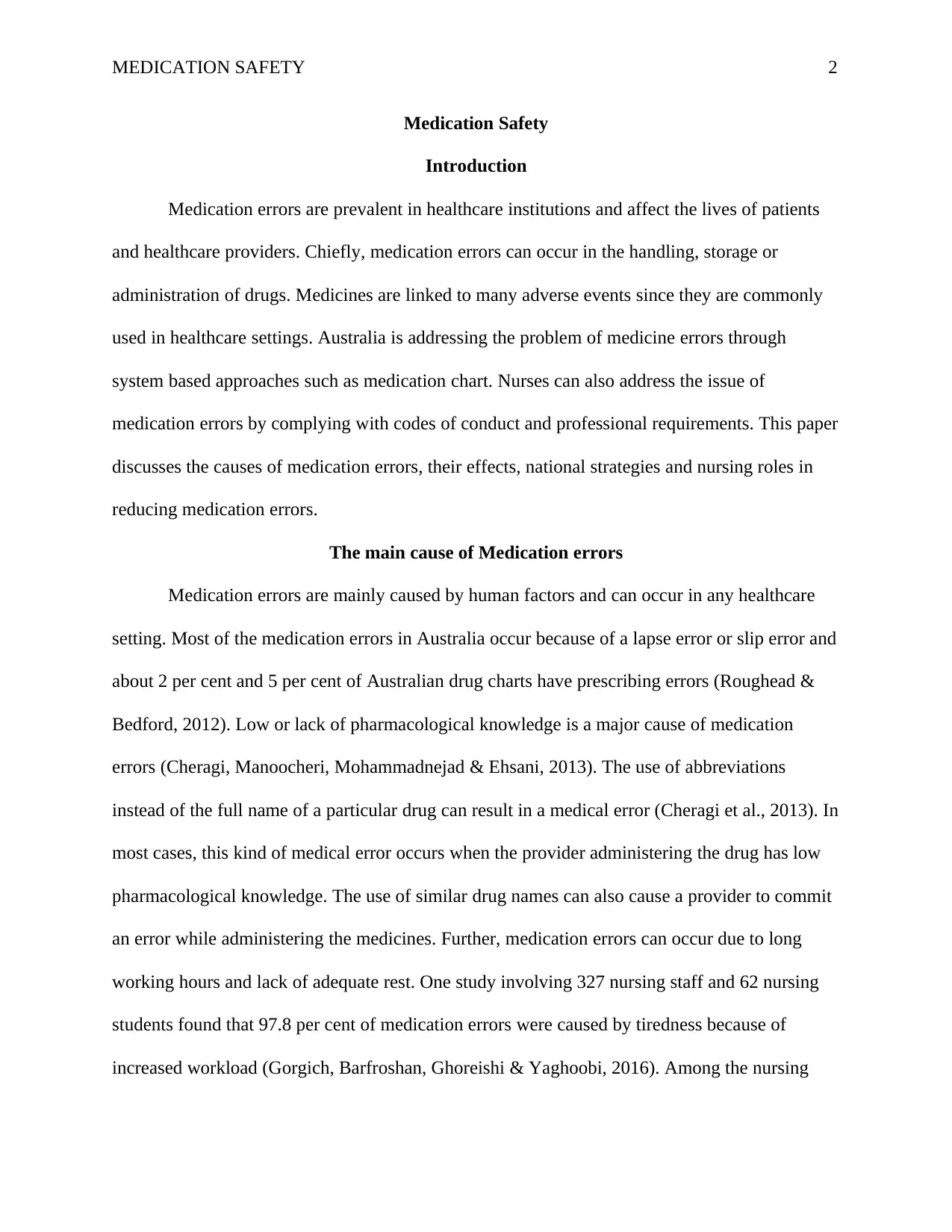
MEDICATION SAFETY 2
Medication Safety
Introduction
Medication errors are prevalent in healthcare institutions and affect the lives of patients
and healthcare providers. Chiefly, medication errors can occur in the handling, storage or
administration of drugs. Medicines are linked to many adverse events since they are commonly
used in healthcare settings. Australia is addressing the problem of medicine errors through
system based approaches such as medication chart. Nurses can also address the issue of
medication errors by complying with codes of conduct and professional requirements. This paper
discusses the causes of medication errors, their effects, national strategies and nursing roles in
reducing medication errors.
The main cause of Medication errors
Medication errors are mainly caused by human factors and can occur in any healthcare
setting. Most of the medication errors in Australia occur because of a lapse error or slip error and
about 2 per cent and 5 per cent of Australian drug charts have prescribing errors (Roughead &
Bedford, 2012). Low or lack of pharmacological knowledge is a major cause of medication
errors (Cheragi, Manoocheri, Mohammadnejad & Ehsani, 2013). The use of abbreviations
instead of the full name of a particular drug can result in a medical error (Cheragi et al., 2013). In
most cases, this kind of medical error occurs when the provider administering the drug has low
pharmacological knowledge. The use of similar drug names can also cause a provider to commit
an error while administering the medicines. Further, medication errors can occur due to long
working hours and lack of adequate rest. One study involving 327 nursing staff and 62 nursing
students found that 97.8 per cent of medication errors were caused by tiredness because of
increased workload (Gorgich, Barfroshan, Ghoreishi & Yaghoobi, 2016). Among the nursing
Medication Safety
Introduction
Medication errors are prevalent in healthcare institutions and affect the lives of patients
and healthcare providers. Chiefly, medication errors can occur in the handling, storage or
administration of drugs. Medicines are linked to many adverse events since they are commonly
used in healthcare settings. Australia is addressing the problem of medicine errors through
system based approaches such as medication chart. Nurses can also address the issue of
medication errors by complying with codes of conduct and professional requirements. This paper
discusses the causes of medication errors, their effects, national strategies and nursing roles in
reducing medication errors.
The main cause of Medication errors
Medication errors are mainly caused by human factors and can occur in any healthcare
setting. Most of the medication errors in Australia occur because of a lapse error or slip error and
about 2 per cent and 5 per cent of Australian drug charts have prescribing errors (Roughead &
Bedford, 2012). Low or lack of pharmacological knowledge is a major cause of medication
errors (Cheragi, Manoocheri, Mohammadnejad & Ehsani, 2013). The use of abbreviations
instead of the full name of a particular drug can result in a medical error (Cheragi et al., 2013). In
most cases, this kind of medical error occurs when the provider administering the drug has low
pharmacological knowledge. The use of similar drug names can also cause a provider to commit
an error while administering the medicines. Further, medication errors can occur due to long
working hours and lack of adequate rest. One study involving 327 nursing staff and 62 nursing
students found that 97.8 per cent of medication errors were caused by tiredness because of
increased workload (Gorgich, Barfroshan, Ghoreishi & Yaghoobi, 2016). Among the nursing
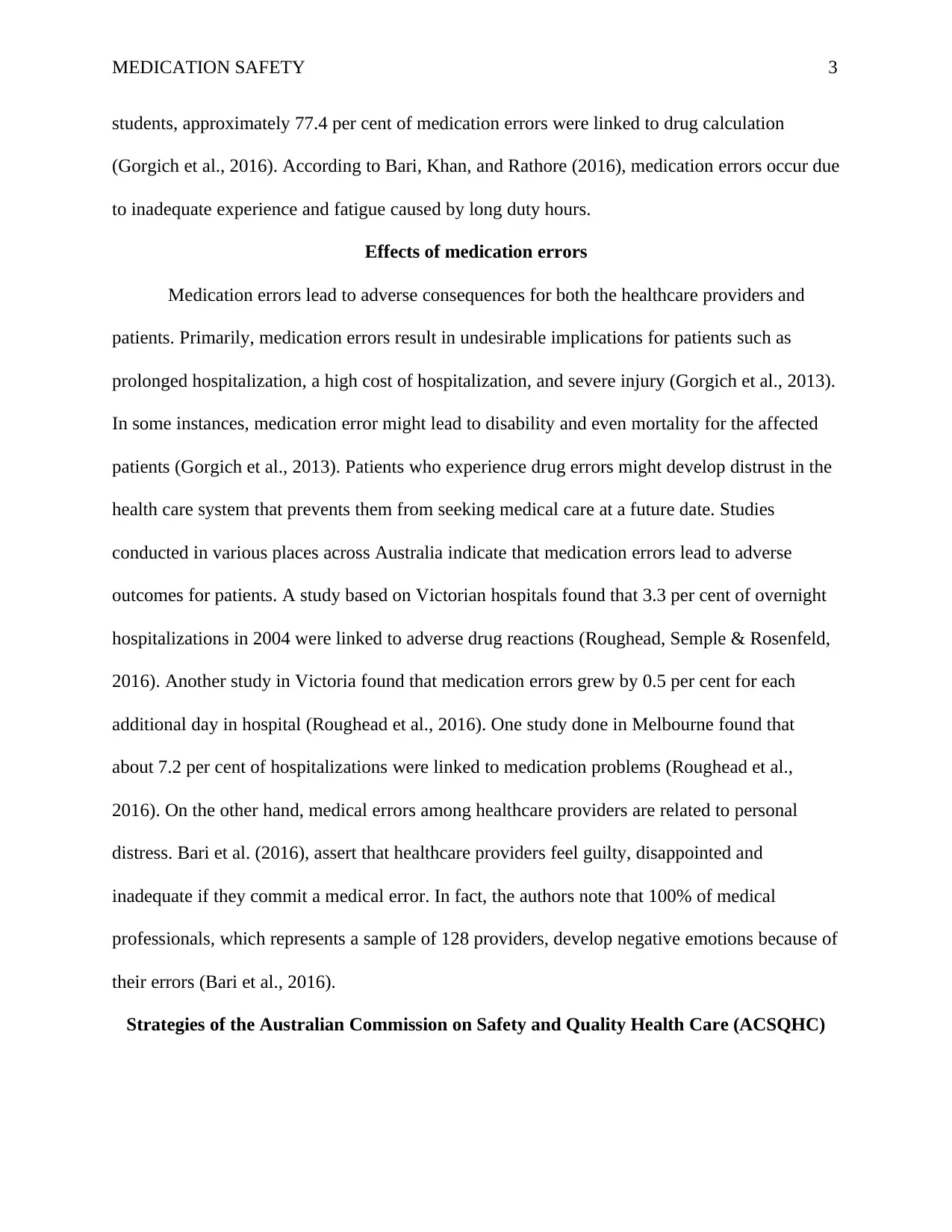
MEDICATION SAFETY 3
students, approximately 77.4 per cent of medication errors were linked to drug calculation
(Gorgich et al., 2016). According to Bari, Khan, and Rathore (2016), medication errors occur due
to inadequate experience and fatigue caused by long duty hours.
Effects of medication errors
Medication errors lead to adverse consequences for both the healthcare providers and
patients. Primarily, medication errors result in undesirable implications for patients such as
prolonged hospitalization, a high cost of hospitalization, and severe injury (Gorgich et al., 2013).
In some instances, medication error might lead to disability and even mortality for the affected
patients (Gorgich et al., 2013). Patients who experience drug errors might develop distrust in the
health care system that prevents them from seeking medical care at a future date. Studies
conducted in various places across Australia indicate that medication errors lead to adverse
outcomes for patients. A study based on Victorian hospitals found that 3.3 per cent of overnight
hospitalizations in 2004 were linked to adverse drug reactions (Roughead, Semple & Rosenfeld,
2016). Another study in Victoria found that medication errors grew by 0.5 per cent for each
additional day in hospital (Roughead et al., 2016). One study done in Melbourne found that
about 7.2 per cent of hospitalizations were linked to medication problems (Roughead et al.,
2016). On the other hand, medical errors among healthcare providers are related to personal
distress. Bari et al. (2016), assert that healthcare providers feel guilty, disappointed and
inadequate if they commit a medical error. In fact, the authors note that 100% of medical
professionals, which represents a sample of 128 providers, develop negative emotions because of
their errors (Bari et al., 2016).
Strategies of the Australian Commission on Safety and Quality Health Care (ACSQHC)
students, approximately 77.4 per cent of medication errors were linked to drug calculation
(Gorgich et al., 2016). According to Bari, Khan, and Rathore (2016), medication errors occur due
to inadequate experience and fatigue caused by long duty hours.
Effects of medication errors
Medication errors lead to adverse consequences for both the healthcare providers and
patients. Primarily, medication errors result in undesirable implications for patients such as
prolonged hospitalization, a high cost of hospitalization, and severe injury (Gorgich et al., 2013).
In some instances, medication error might lead to disability and even mortality for the affected
patients (Gorgich et al., 2013). Patients who experience drug errors might develop distrust in the
health care system that prevents them from seeking medical care at a future date. Studies
conducted in various places across Australia indicate that medication errors lead to adverse
outcomes for patients. A study based on Victorian hospitals found that 3.3 per cent of overnight
hospitalizations in 2004 were linked to adverse drug reactions (Roughead, Semple & Rosenfeld,
2016). Another study in Victoria found that medication errors grew by 0.5 per cent for each
additional day in hospital (Roughead et al., 2016). One study done in Melbourne found that
about 7.2 per cent of hospitalizations were linked to medication problems (Roughead et al.,
2016). On the other hand, medical errors among healthcare providers are related to personal
distress. Bari et al. (2016), assert that healthcare providers feel guilty, disappointed and
inadequate if they commit a medical error. In fact, the authors note that 100% of medical
professionals, which represents a sample of 128 providers, develop negative emotions because of
their errors (Bari et al., 2016).
Strategies of the Australian Commission on Safety and Quality Health Care (ACSQHC)
⊘ This is a preview!⊘
Do you want full access?
Subscribe today to unlock all pages.

Trusted by 1+ million students worldwide
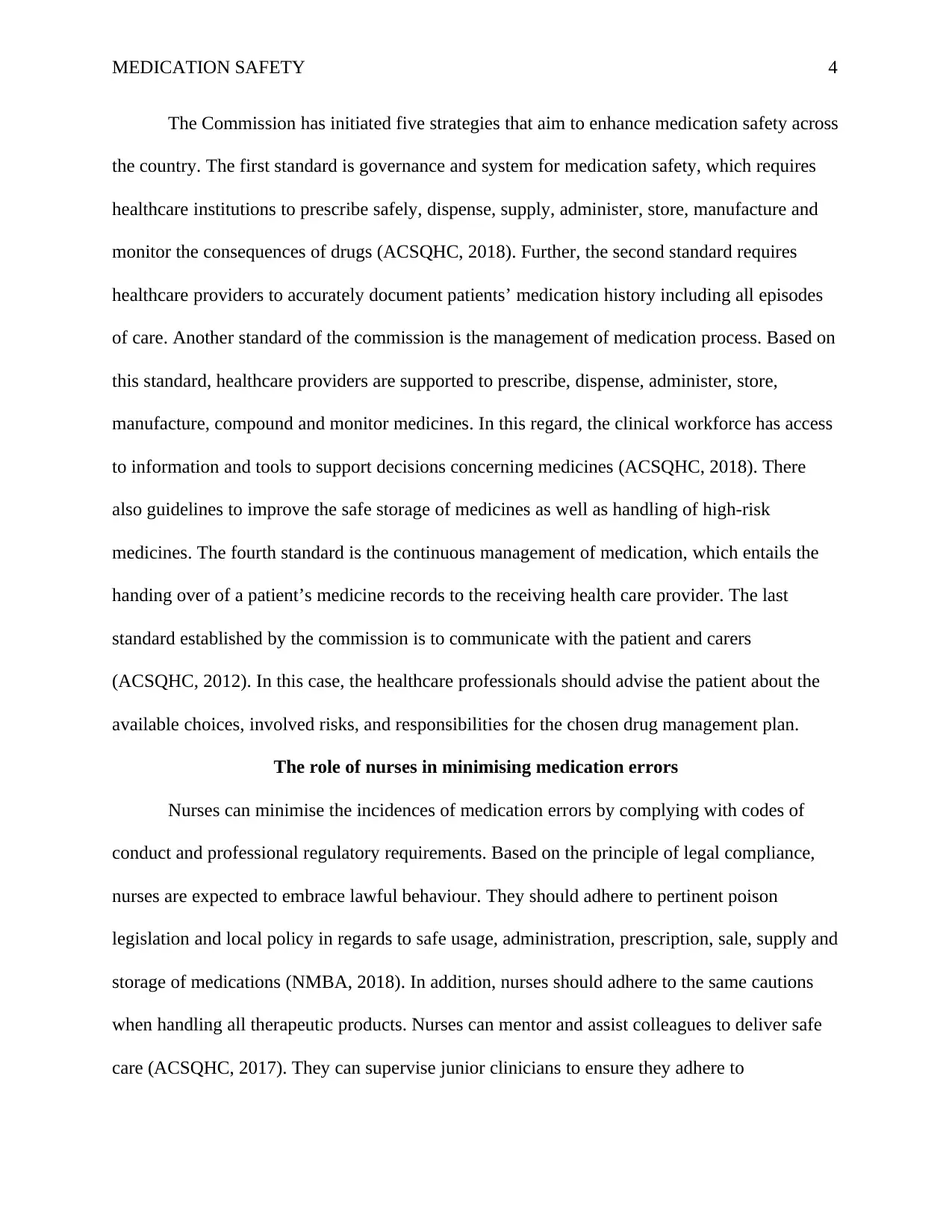
MEDICATION SAFETY 4
The Commission has initiated five strategies that aim to enhance medication safety across
the country. The first standard is governance and system for medication safety, which requires
healthcare institutions to prescribe safely, dispense, supply, administer, store, manufacture and
monitor the consequences of drugs (ACSQHC, 2018). Further, the second standard requires
healthcare providers to accurately document patients’ medication history including all episodes
of care. Another standard of the commission is the management of medication process. Based on
this standard, healthcare providers are supported to prescribe, dispense, administer, store,
manufacture, compound and monitor medicines. In this regard, the clinical workforce has access
to information and tools to support decisions concerning medicines (ACSQHC, 2018). There
also guidelines to improve the safe storage of medicines as well as handling of high-risk
medicines. The fourth standard is the continuous management of medication, which entails the
handing over of a patient’s medicine records to the receiving health care provider. The last
standard established by the commission is to communicate with the patient and carers
(ACSQHC, 2012). In this case, the healthcare professionals should advise the patient about the
available choices, involved risks, and responsibilities for the chosen drug management plan.
The role of nurses in minimising medication errors
Nurses can minimise the incidences of medication errors by complying with codes of
conduct and professional regulatory requirements. Based on the principle of legal compliance,
nurses are expected to embrace lawful behaviour. They should adhere to pertinent poison
legislation and local policy in regards to safe usage, administration, prescription, sale, supply and
storage of medications (NMBA, 2018). In addition, nurses should adhere to the same cautions
when handling all therapeutic products. Nurses can mentor and assist colleagues to deliver safe
care (ACSQHC, 2017). They can supervise junior clinicians to ensure they adhere to
The Commission has initiated five strategies that aim to enhance medication safety across
the country. The first standard is governance and system for medication safety, which requires
healthcare institutions to prescribe safely, dispense, supply, administer, store, manufacture and
monitor the consequences of drugs (ACSQHC, 2018). Further, the second standard requires
healthcare providers to accurately document patients’ medication history including all episodes
of care. Another standard of the commission is the management of medication process. Based on
this standard, healthcare providers are supported to prescribe, dispense, administer, store,
manufacture, compound and monitor medicines. In this regard, the clinical workforce has access
to information and tools to support decisions concerning medicines (ACSQHC, 2018). There
also guidelines to improve the safe storage of medicines as well as handling of high-risk
medicines. The fourth standard is the continuous management of medication, which entails the
handing over of a patient’s medicine records to the receiving health care provider. The last
standard established by the commission is to communicate with the patient and carers
(ACSQHC, 2012). In this case, the healthcare professionals should advise the patient about the
available choices, involved risks, and responsibilities for the chosen drug management plan.
The role of nurses in minimising medication errors
Nurses can minimise the incidences of medication errors by complying with codes of
conduct and professional regulatory requirements. Based on the principle of legal compliance,
nurses are expected to embrace lawful behaviour. They should adhere to pertinent poison
legislation and local policy in regards to safe usage, administration, prescription, sale, supply and
storage of medications (NMBA, 2018). In addition, nurses should adhere to the same cautions
when handling all therapeutic products. Nurses can mentor and assist colleagues to deliver safe
care (ACSQHC, 2017). They can supervise junior clinicians to ensure they adhere to
Paraphrase This Document
Need a fresh take? Get an instant paraphrase of this document with our AI Paraphraser
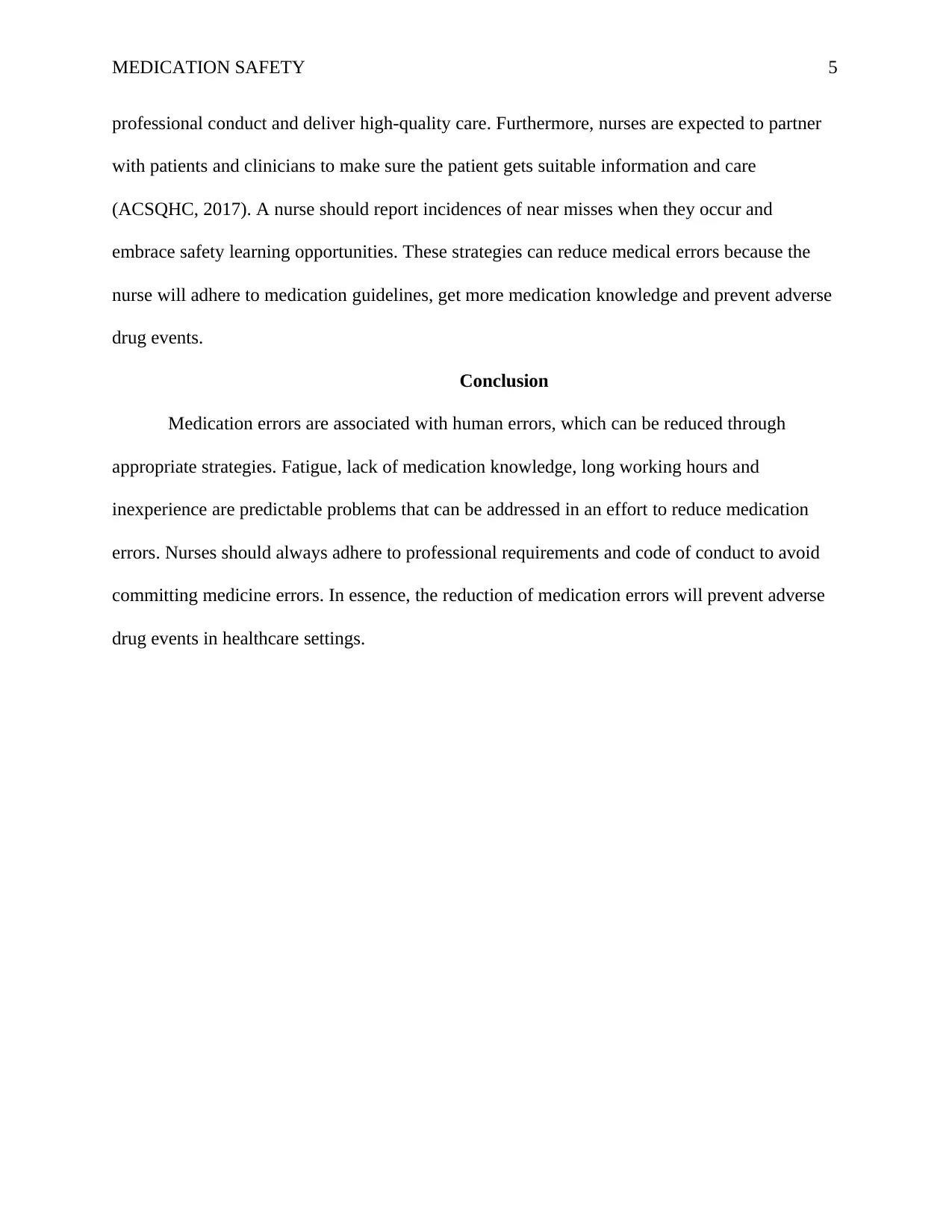
MEDICATION SAFETY 5
professional conduct and deliver high-quality care. Furthermore, nurses are expected to partner
with patients and clinicians to make sure the patient gets suitable information and care
(ACSQHC, 2017). A nurse should report incidences of near misses when they occur and
embrace safety learning opportunities. These strategies can reduce medical errors because the
nurse will adhere to medication guidelines, get more medication knowledge and prevent adverse
drug events.
Conclusion
Medication errors are associated with human errors, which can be reduced through
appropriate strategies. Fatigue, lack of medication knowledge, long working hours and
inexperience are predictable problems that can be addressed in an effort to reduce medication
errors. Nurses should always adhere to professional requirements and code of conduct to avoid
committing medicine errors. In essence, the reduction of medication errors will prevent adverse
drug events in healthcare settings.
professional conduct and deliver high-quality care. Furthermore, nurses are expected to partner
with patients and clinicians to make sure the patient gets suitable information and care
(ACSQHC, 2017). A nurse should report incidences of near misses when they occur and
embrace safety learning opportunities. These strategies can reduce medical errors because the
nurse will adhere to medication guidelines, get more medication knowledge and prevent adverse
drug events.
Conclusion
Medication errors are associated with human errors, which can be reduced through
appropriate strategies. Fatigue, lack of medication knowledge, long working hours and
inexperience are predictable problems that can be addressed in an effort to reduce medication
errors. Nurses should always adhere to professional requirements and code of conduct to avoid
committing medicine errors. In essence, the reduction of medication errors will prevent adverse
drug events in healthcare settings.
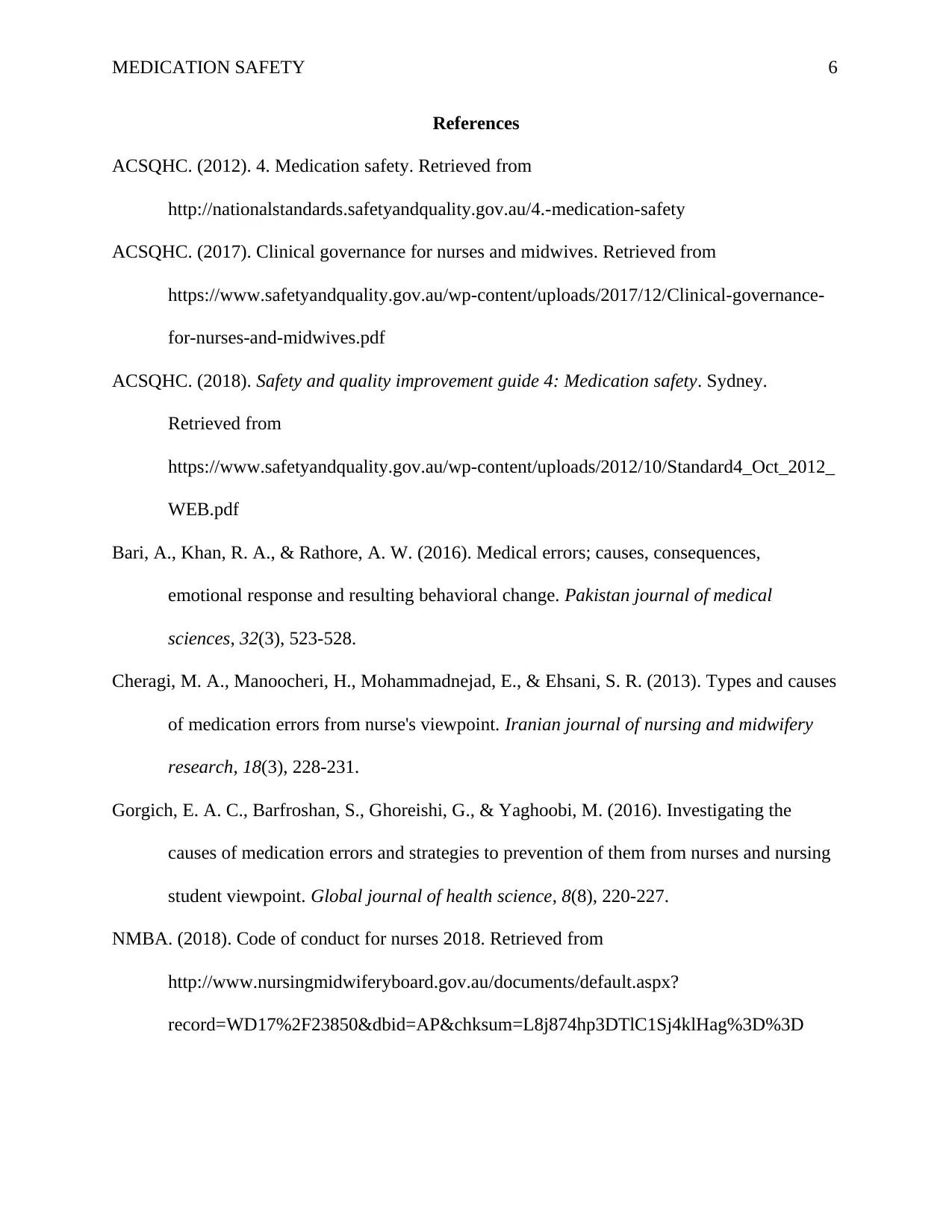
MEDICATION SAFETY 6
References
ACSQHC. (2012). 4. Medication safety. Retrieved from
http://nationalstandards.safetyandquality.gov.au/4.-medication-safety
ACSQHC. (2017). Clinical governance for nurses and midwives. Retrieved from
https://www.safetyandquality.gov.au/wp-content/uploads/2017/12/Clinical-governance-
for-nurses-and-midwives.pdf
ACSQHC. (2018). Safety and quality improvement guide 4: Medication safety. Sydney.
Retrieved from
https://www.safetyandquality.gov.au/wp-content/uploads/2012/10/Standard4_Oct_2012_
WEB.pdf
Bari, A., Khan, R. A., & Rathore, A. W. (2016). Medical errors; causes, consequences,
emotional response and resulting behavioral change. Pakistan journal of medical
sciences, 32(3), 523-528.
Cheragi, M. A., Manoocheri, H., Mohammadnejad, E., & Ehsani, S. R. (2013). Types and causes
of medication errors from nurse's viewpoint. Iranian journal of nursing and midwifery
research, 18(3), 228-231.
Gorgich, E. A. C., Barfroshan, S., Ghoreishi, G., & Yaghoobi, M. (2016). Investigating the
causes of medication errors and strategies to prevention of them from nurses and nursing
student viewpoint. Global journal of health science, 8(8), 220-227.
NMBA. (2018). Code of conduct for nurses 2018. Retrieved from
http://www.nursingmidwiferyboard.gov.au/documents/default.aspx?
record=WD17%2F23850&dbid=AP&chksum=L8j874hp3DTlC1Sj4klHag%3D%3D
References
ACSQHC. (2012). 4. Medication safety. Retrieved from
http://nationalstandards.safetyandquality.gov.au/4.-medication-safety
ACSQHC. (2017). Clinical governance for nurses and midwives. Retrieved from
https://www.safetyandquality.gov.au/wp-content/uploads/2017/12/Clinical-governance-
for-nurses-and-midwives.pdf
ACSQHC. (2018). Safety and quality improvement guide 4: Medication safety. Sydney.
Retrieved from
https://www.safetyandquality.gov.au/wp-content/uploads/2012/10/Standard4_Oct_2012_
WEB.pdf
Bari, A., Khan, R. A., & Rathore, A. W. (2016). Medical errors; causes, consequences,
emotional response and resulting behavioral change. Pakistan journal of medical
sciences, 32(3), 523-528.
Cheragi, M. A., Manoocheri, H., Mohammadnejad, E., & Ehsani, S. R. (2013). Types and causes
of medication errors from nurse's viewpoint. Iranian journal of nursing and midwifery
research, 18(3), 228-231.
Gorgich, E. A. C., Barfroshan, S., Ghoreishi, G., & Yaghoobi, M. (2016). Investigating the
causes of medication errors and strategies to prevention of them from nurses and nursing
student viewpoint. Global journal of health science, 8(8), 220-227.
NMBA. (2018). Code of conduct for nurses 2018. Retrieved from
http://www.nursingmidwiferyboard.gov.au/documents/default.aspx?
record=WD17%2F23850&dbid=AP&chksum=L8j874hp3DTlC1Sj4klHag%3D%3D
⊘ This is a preview!⊘
Do you want full access?
Subscribe today to unlock all pages.

Trusted by 1+ million students worldwide
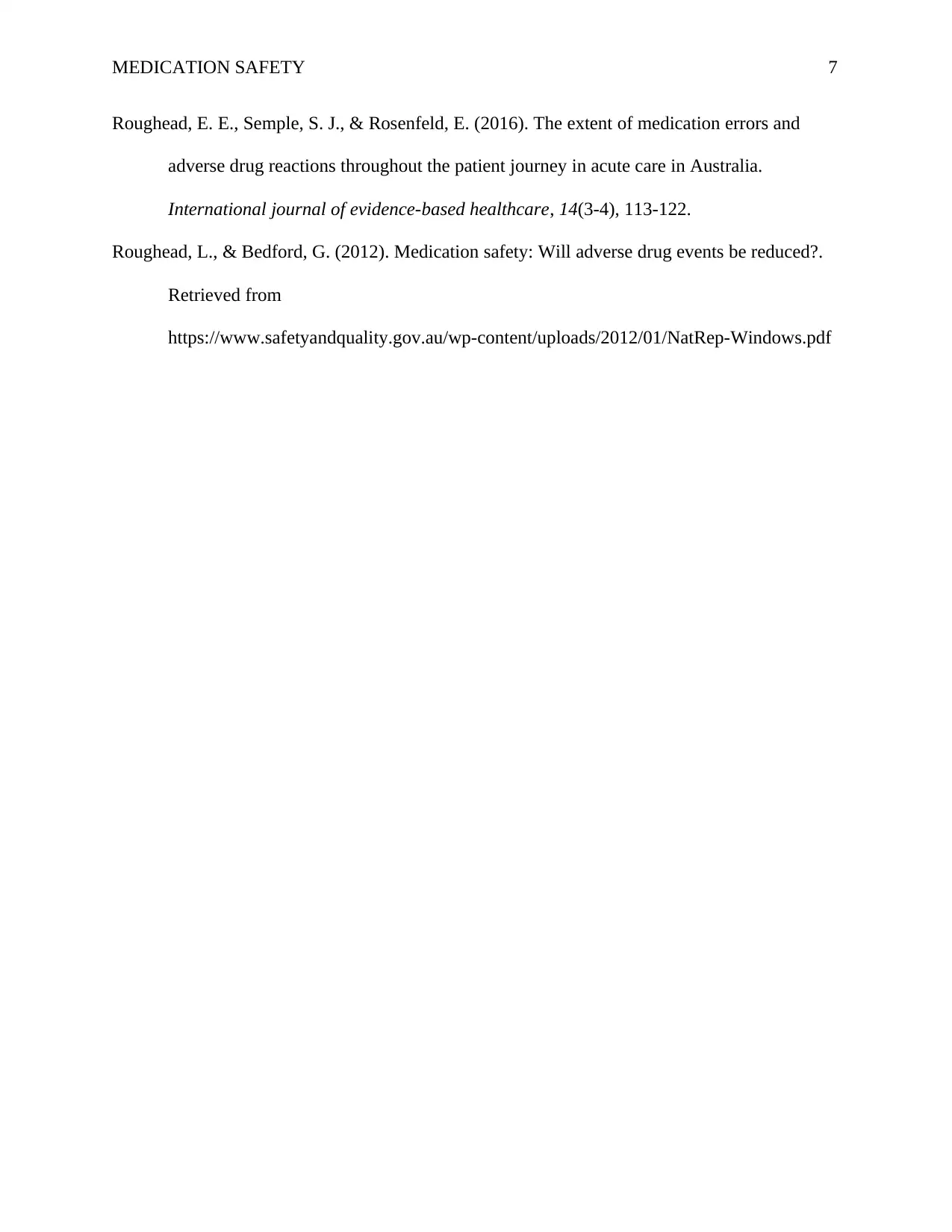
MEDICATION SAFETY 7
Roughead, E. E., Semple, S. J., & Rosenfeld, E. (2016). The extent of medication errors and
adverse drug reactions throughout the patient journey in acute care in Australia.
International journal of evidence-based healthcare, 14(3-4), 113-122.
Roughead, L., & Bedford, G. (2012). Medication safety: Will adverse drug events be reduced?.
Retrieved from
https://www.safetyandquality.gov.au/wp-content/uploads/2012/01/NatRep-Windows.pdf
Roughead, E. E., Semple, S. J., & Rosenfeld, E. (2016). The extent of medication errors and
adverse drug reactions throughout the patient journey in acute care in Australia.
International journal of evidence-based healthcare, 14(3-4), 113-122.
Roughead, L., & Bedford, G. (2012). Medication safety: Will adverse drug events be reduced?.
Retrieved from
https://www.safetyandquality.gov.au/wp-content/uploads/2012/01/NatRep-Windows.pdf
1 out of 7
Related Documents
Your All-in-One AI-Powered Toolkit for Academic Success.
+13062052269
info@desklib.com
Available 24*7 on WhatsApp / Email
![[object Object]](/_next/static/media/star-bottom.7253800d.svg)
Unlock your academic potential
Copyright © 2020–2025 A2Z Services. All Rights Reserved. Developed and managed by ZUCOL.





